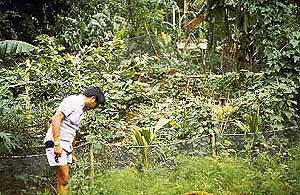|
Trophic complexity approaching natural systems. Multiple interactions between plants, weeds, pathogens and insects

|
|
Small traditional garden
|
Traditional agro-ecosystems tend to mimic natural ecosystems. Monocultures are at the opposite extreme of a trophic complexity continuum. Modern farming systems tend to repress natural processes like plant succession, and nutrient cycling, resulting in the necessity of continuous effort or inputs to control weeds, plant crops, repress pests and supply nutrients. Traditional farmers take advantage of natural processes to reduce inputs and increase stability. As in natural ecosystems, natural enemies control insect damage, nutrients are cycled, inputs are low, and outputs are diverse. "The organization of plants is an imitation of natural ecosystems especially in regards to species diversity, the extent of vegetation cover and the variety of symbiotic complexes present. This results in the ultimate development of a closed nutrient cycle and mechanisms that provide protection against damage by disease, pests and wind" (Hills, 1988).
Polycultures generally have far fewer problems with insect pests (Thurston, 1992). The structural complexity of the field provides habitats for insect predators like parasitic wasps, spiders and ladybugs. Complex interactions between insects, their predators and the plants, ensure natural fluctuations in insect populations rather than destructive cycles and pest outbreaks. Thus insects are controlled naturally, with few chemical inputs.
An excellent example of using natural processes instead of chemical agents is provided by swidden slash and burn agriculture. After a plot is cleared and planted, only a few crops can be grown before nutrients are depleted and weeds start to invade. To alter this natural process, external fertilizers and herbicides would have to be applied at a great expense. This is often accompanied by undesirable consequences for the surrounding environment and acidification of the soil. Traditional farmers work with the natural succession of the forest by allowing the plot to go fallow. This reestablishes the soil nutrients naturally and results in a mature, weed-free forest that can again be cut and planted in a sustainable manner.
|
|
